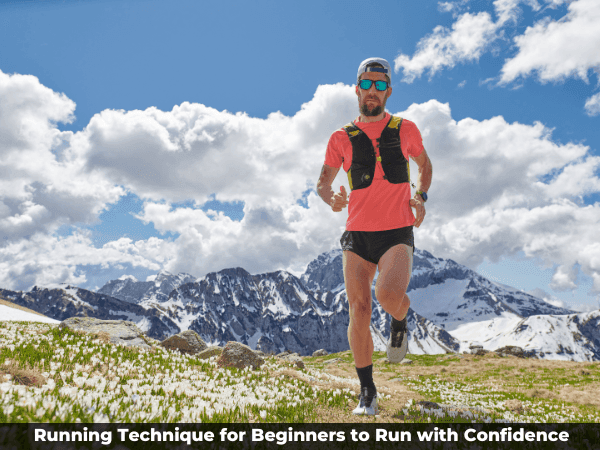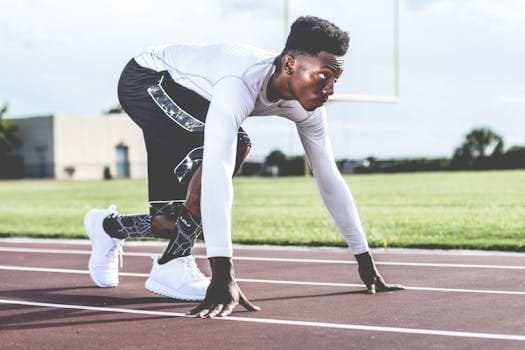
Introduction
Running is one of the best ways to stay fit while adding a bit of fun to exercise. However, for beginners, running might feel challenging or even intimidating. This is why learning the right Running Technique for Beginners is so important; it sets a solid foundation for building speed, increasing distance, and achieving fitness goals. By following the correct posture and techniques from the start, beginners can experience smoother runs and enjoy the long-term benefits of improved fitness and endurance. Adopting proper form and technique enhances the running experience and leads to a healthier, more enjoyable journey.
The most important benefit of mastering these specific skills and practices is avoiding injury. Good form while running tips always prevents muscle or joint fatigue as it helps reduce activity stresses, helping one avoid standard issues such as shin splints or even knee pains. Additionally, running efficiently allows runners to expend less energy, allowing longer runs and increasing endurance. And, of course, let’s tackle the fun aspect. When a person’s body is strong and able, running can be very fulfilling and fun.
Given the right techniques, beginners can build a great foundation for what could be a lifelong running journey. This guide will help you master these primary techniques, thus allowing you to step out of the house confidently and knowing that each running session is a step closer to getting fit.
Why Good Running Technique is Essential for Runners

Most beginners in a running regime may find it an uphill task. Some of the problems faced include becoming out of breath excessively. Otherwise, it tends to be some muscle group that would also ache and have inadequate stamina levels. Such scenarios are discouraging, but proper techniques and the enthusiasm to learn running can help avoid such situations. This is because adequate technique caters to the biomechanics of running and the overall feeling while running, both of which enhance the enjoyment associated with the activity.
Running technique for beginners do matter; they influence your performance in a great way. For instance, a good running form allows you to utilize energy more efficiently and thus cover greater distances without expending much in fatigue. Such advantages go a long way in limiting the stress or excessive load that may be placed on muscles or joints, which are associated with injuries such as shin splits or knee pains, often resulting from poor run form. Such advantages make a day and night difference in injury-free running comfortably and frequently.
Last but not least, confidence is also essential when it comes to keeping up with a running routine. It feels great when you know that your form is right while pushing through with the run, as it gives you confidence and control. This type of confidence can also enable one to incorporate running into one’s lifestyle, which makes an individual feel that the targets are being gradually accomplished. When one aims to achieve proper running technique for beginners of the journey, it prepares them to become more resilient and content with their long-term running experience.
Preparing to Run with Confidence

One of the most important elements in developing this confidence is to go on the running journey with the right attitude and adequate preparation. One of the first few steps is to try and set achievable and realistic short and long-term aims, especially in their mind. For the first time, it helps to aim for small wins, like a certain amount of time spent running or distance covered, which keeps you motivated and less stressed. This approach allows you to widen your accomplishments with each step through gradual development.
It is obvious that warming up adequately is just as necessary. It is about loosening up the muscles and joints and easing into the required intensity and the desired pace. Hence, leg swings, arm circles, high knees, or similar stretches should be done initially to warm and help us lose the body. Warmup is also useful in which one does not feel the strain while running or at the beginning of her session.
Finally, running shoes and clothes have a considerable impact and should be selected properly to feel good and provide adequate support. Running shoes are supposed to fit properly, but they must have a good amount of fitness, supporting the foot’s nature. Comfy clothes designed for movement and breathability can do wonders where the clothes do not restrain motion during activity while allowing one to remain cool. The presence of comfortable clothes enables one to concentrate on the running instead of the discomfort, which allows for an easy runs and confident runs.
10 Best Running Technique for Beginners
Starting a running routine can be both exciting and challenging for beginners. Whether aiming to boost fitness, relieve stress, or enjoy the outdoors, using the right techniques can make a huge difference. By focusing on proper form, breathing, and pacing, you can avoid common injuries, improve endurance, and make running easier and more enjoyable. Here are the ten best running technique for beginners to help run confidently and establish a lasting running habit.
Maintain Proper Posture
For beginner runners, it is important to maintain the right posture as this will often serve as the base for running rather efficiently and comfortably shortly. Maintaining an erect posture when running allows for better body mechanics and proper breathing techniques. As a start, let the head be raised, and the eyes be looking straight rather than down. This posture facilitates the opening of the shoulders, allowing for better and deeper breaths necessary for maintaining muscle oxygen levels.
Keep your shoulders low and do not hunch them, as this will tire the arms and restrict air intake due to elevation tension. Picture a straight line between your head and your heels, as if you are being pulled up softly from the crown of your head.
The ability to run well rather, predominately the right posture, will ensure that the individual can improve their breathing ability while also maintaining sufficient tone in the neck, back, and shoulders, making it easier to tolerate long periods of running.
Focus on Foot Strike
An often underestimated aspect of one’s running mechanics is the foot strike. Many people are prone to landing on their heel when they run, causing heel jolts, subsequent discomfort, and possible injury. Instead, runners should aim for a mid-foot strike, which distributes stress evenly across the foot. This way, the impact is more evenly distributed across joints, leading to less strain on the ankles, knee joints, and hips.
There’s nothing more to it – simply aiming for a mid-foot strike will also make each step much easier and move forward. If you work on this technique, you will significantly reduce the impact on your joints and allow yourself to run much more steadily.
Shorten Your Strid
In a very effective manner, shortening your stride can decrease injury risk and enhance running efficiency. This is a common flaw, hailing it overstriding. It results in long steps, adding unnecessary pressure to the knees and the ankles, which can increase muscle strain or joint pain.
However, with shorter and more rapid steps, the feet land more closely to one’s center of gravity, giving the necessary balance and lowering the chance of ”braking” after each step.
This saves energy and makes it possible to maintain a steady rhythm, which leads to a comfortable speed. Thrusting stresses on upper limbs while concentrating on lower limbs influence a shorter stride, increasing stability and assisting the development of endurance while not overstretching the muscles.
Control Arm Movement
While running, your arms assist in keeping the body balanced and stable. Ensure that your arms remain bent at right angles and that their motion is a forward-backward swing without crossing over the chest. Crossing arms over the torso leads to arms punching forward and then launching backward the arm, creating rotational movement when it isn’t necessary, affecting balance and wasting energy.
Restricted arm movement enables proper body alignment and balance, allowing for better leg action. Eventually, you exert little energy and maintain a steady rhythm because your arm movements are smooth.
Practice Rhythmic Breathing
Efficiently, one should be able to run longer distances due to the ease that comes with it. Many newcomers will tend to breathe through the chest, which only leads to shallow, fatigued gasps that only serve to fill the chest area. Instead, adopt breathing patterns such as inhaling for three and exhaling for two.
Another one of many different kinds of breathing techniques, this one is focused on the maximum use of gravity to pull the diaphragm downward and outwards as the breath expands the belly. This way, more oxygen is brought into the lungs, helping the body’s muscles burn fuel effectively.
Deep, steady breaths in and out ensure that a particular pace is maintained with a reduced risk of experiencing side stitches, a common problem in beginners. The regularity of the breath rhythm will create a better sense of the muscle’s endurance, leading to a more pleasant and controllable running process.
Engage Your Core Muscles
Proper core engagement and muscle control are fundamental when it comes to running. Jordan explains that a core with muscle houses allows for appropriate structure and less needless action, resulting in higher energy efficiency. As you run, draw your navel closer to your spine to activate your core.
This movement allows the stomach muscles to be activated without too much tension, providing a solid base that gives leeway to the lower back.
An active core aids in maintaining an erect upper body while running, which minimizes the chances of slumping or leaning forward and hinders the breathing cycle. Thus, core strengthening & core engagement comes into play for a stronger, cool-controlled cadence with higher endurance.
Understand The Importance Of Pace
Understanding how to keep pace while running appears crucial for optimal performance. The running speed allows for powerful propulsion and should be reasonable enough to maintain repetitive motion. For most runners, proper pacing is around 70-80% of their maximal effort.
This also means that a given cadence multiplied by maximal effort offers a more efficient way forward and is less likely to cause wear on one’s joints. To keep this pace, you can use a metronome app or count how many steps you take each time.
Once you gain a reasonable running rhythm and pacing, it also protects the body from injury and enables a much wider range of distance to be comfortably covered.
Start with a Run-Walk Method
The run-walk method is particularly suitable for first-timers, as it increases a person’s endurance with minimum stress on the body. By incorporating running into the program in intervals, a person builds confidence while practicing endurance without needing continuous running.
For instance, running for 1 minute, walking for 2 minutes during the first phases, and increasing the running volume with time can be a strategy.
Such an approach is good for the joints and muscles, wears them out minimally, and makes adherence to pre workouts easier. This method effectively builds fitness levels progressively and makes incorporating running into your routine enjoyable.
Warm Up and Cool Down Properly
An individually designed warmup and a cooldown are paramount when running and after running. Math does the warmup in 5- 10 minutes, and dynamic events are created, like leg swaying and arm motions, because these increase the blood supply by opening muscles. Warming up lessens the chance of straining or injuring a muscle while it’s in action.
For example, bring a 1:2 ratio in muscle memory building against muscle activity undertaken. After every run, do static stretches of the hamstring or the calves to unwind and de-stiff the muscles. Exercising keeps your heart rate elevated for extended periods if done effectively.
A good cooldown generates less lactic acid, which causes fatigue and reduces the time frame needed to recover. The infusion of warmup and cooldown is necessary for the overall concept of progressive and long-term running.
Listen to Your Body and Rest When Needed
As a beginner, you need to understand that your body is an important asset worth taking care of. This helps as running is high-impact, so you must take a break when your body or muscles start experiencing discomfort, pain, or soreness.
Pain should not be considered a badge of honor. It would help if you treated it as an injury because it can lead to more serious injuries in the future, affecting your capability to progress. Rest days play a vital role in ensuring that your muscles recover, repair, and become stronger as they reduce the chances of fatigue and save you from losing enthusiasm.
With time, paying attention to the signs emanating from your body will be beneficial for developing a running schedule that optimally works for you. Integrating rest days into your training program is essential for growth athletes seeking to grow in the sport.
Conclusion
To conclude, learning the fundamentals of running technique for beginners is very important for novice runners to avoid the most frequent mistakes. Proper body posture, mid-foot focus, shorter strides, restricted arm movements, and consistent breath rate are essential techniques that promote effective and pleasurable running.
When zipping up the core, maintaining a rhythm, and utilizing the run-walk strategy, one is engaged from the beginning and sails through the training with improved stability and strength. Also, warming up, cooling down, and paying attention to the stresses your body experiences are great rules that guarantee safe, reasonable, and sustainable exercise routines.
Running is a repetitive activity that takes time for the development of new performance and improvement in existing performance. Concentrate on the posture, set targets of smaller time frames about each running practice, and enjoy each new run since it is a chance to improve. Over time, these tactics will come unconsciously with practice and make things feel natural, increasing comfort and confidence in performance.
The final words are, do not hesitate now to put the fundamental techniques into action for the first time, which is often the hardest. Every stride or step takes you closer to your aim and objectives, so remember that while running. Running is never easy, but you must remember that in the end, performing the running technique for beginners and being consistent will help you build your confidence, strength, and enjoyment of the process. So take your shoes, leave your comfort zone, and relish every moment of this great practical experience!








